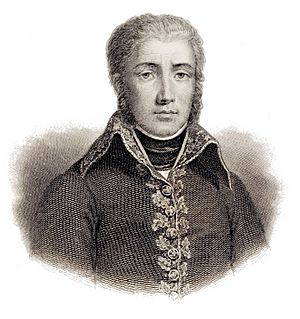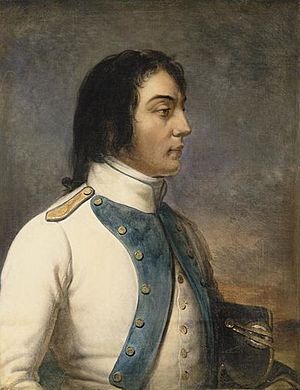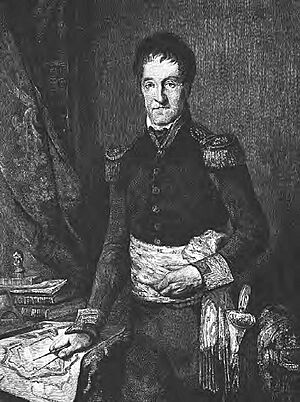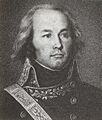Battle of Ettlingen facts for kids
Quick facts for kids Battle of Ettlingen |
|||||||
|---|---|---|---|---|---|---|---|
| Part of the French Revolutionary War | |||||||
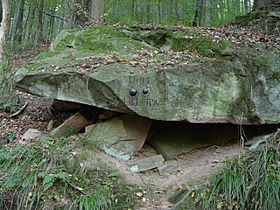 Two cannonballs embedded in a large boulder have the date 9.10.Juli.1796 inscribed in the stone. |
|||||||
|
|||||||
| Belligerents | |||||||
| Commanders and leaders | |||||||
| Units involved | |||||||
| Army of Rhin-et-Moselle | Army of the Upper Rhine | ||||||
| Strength | |||||||
| 36,000 | 32,000 | ||||||
| Casualties and losses | |||||||
| 2,400 | 2,600 | ||||||
The Battle of Ettlingen (also called the Battle of Malsch) happened on 9 July 1796. It was a big fight during the French Revolutionary Wars. The battle took place near the town of Malsch in present-day Germany. French soldiers from the First French Republic fought against soldiers from Habsburg Austria.
The Austrian army was led by Archduke Charles, Duke of Teschen. He wanted to stop the French army from moving north. The French army was led by Jean Victor Marie Moreau. His army was called the Army of Rhin-et-Moselle. After a tough day of fighting, the French won. The Austrians had to retreat east towards Stuttgart.
Contents
Why the Battle Happened
The Big Picture: French Revolutionary Wars
The Battle of Ettlingen was part of the French Revolutionary Wars. These wars were fought between France and many European countries. In 1796, France was trying to push into Germany. Austria was trying to stop them.
The French had two main armies in this area. Jean-Baptiste Jourdan led the Army of Sambre-et-Meuse in the north. Jean Victor Marie Moreau led the Army of Rhin-et-Moselle in the south. The Austrian armies were also split. Archduke Charles, Duke of Teschen was in charge of the northern Austrian army. Maximilian Anton Karl, Count Baillet de Latour led the southern Austrian army.
French Plan to Attack
The French leaders had a clever plan. They wanted both French armies to attack at the same time. Jourdan's army would attack first in the north. This was meant to draw Austrian soldiers away. Then, Moreau's army would cross the Rhine River in the south. This would give Moreau a better chance to attack.
The plan worked well at first. Jourdan's army won a battle in the north. This made Archduke Charles rush his troops to help. While Charles was busy in the north, Moreau's army crossed the Rhine River on 23–24 June. This crossing was a big success for the French.
Austrians Try to Stop Moreau
After crossing the Rhine, Moreau's army pushed forward. They won another battle against Latour's Austrian army on 5 July. This forced the Austrians to fall back. Archduke Charles heard about Moreau's success. He quickly moved his main army south to stop Moreau.
Charles wanted to block Moreau's advance along the Alb River. This river was near Ettlingen. The two armies met there, ready for a major fight.
The Battle of Ettlingen
Armies Get Ready
On 9 July 1796, Moreau decided to attack. He didn't know that Archduke Charles had also planned to attack the next day. Moreau wanted to hold the Austrians in the flat land near the Rhine. At the same time, he planned to send troops around their left side in the Black Forest mountains.
Archduke Charles also had a plan. He wanted to go around the French left side near the river. He hoped to take back the town of Gernsbach. The Austrian army was set up in four main groups. Latour's group was on the right, near the Rhine. Sztáray's group was in the middle, near Malsch. Kaim's group was on the left-center in the hills. Lindt's Saxon soldiers were on the far left.
Fighting in the Plains and Mountains
The battle was very tough. In the flat plains near the Rhine, the town of Malsch was captured and recaptured several times. Latour tried to use his cavalry to get around the French. But the French cavalry stopped them. The fighting in the plains lasted until late at night.
Meanwhile, in the mountains, the French had more success. Saint-Cyr's French troops moved through the Black Forest. They faced Kaim's Austrian soldiers. Kaim had strong defenses in the hills. Saint-Cyr used a clever trick. He ordered his soldiers to attack, then pretend to retreat. This made the Austrians rush out of their strong positions.
When the Austrians chased them, Saint-Cyr's hidden troops attacked their sides. This surprised the Austrians. The French fought hard and pushed the Austrians back. They caused many losses for Kaim's troops and captured two cannons. Kaim's soldiers had to retreat further east.
After the Battle
French Victory and Austrian Retreat
The Battle of Ettlingen was a French victory. The French lost about 2,400 soldiers. The Austrians lost about 2,600 soldiers. On 10 July, Archduke Charles ordered his army to leave Malsch. They marched quickly east towards Pforzheim.
Moreau's French army moved into Ettlingen and Neuenbürg. Charles stopped at Pforzheim for a few days to protect his supplies. Moreau was careful and waited around Ettlingen for several days. He didn't believe Charles had truly given up. But on 14 July, the Austrians packed their supplies and left Pforzheim. Moreau followed the next day, but Charles was already gone.
What Happened Next
When Archduke Charles left the Rhine valley, he left about 30,000 soldiers in forts along the river. These soldiers were meant to guard important places like Mainz and Mannheim. However, these garrisons mostly stayed quiet. This meant Charles lost the help of these 30,000 soldiers.
Also, the German allies who fought with Austria started to make deals with the French. Their lands were now occupied by the French army. This weakened the Austrian side even more.
Some historians believe that Charles could have stayed near the Rhine. He might have been able to defeat the French armies one by one. But the French strategy, planned by Lazare Carnot, was to attack from two sides. This strategy had worked before. The next big battle in this campaign was the Battle of Neresheim on 11 August.
Images for kids
External sources
These sources identify the Austrian regiment numbers.
- German Wikipedia List of Austrian Cavalry Regiments
These sources provide the full names and other identifying information of French and Austrian generals from the Napoleonic period.



